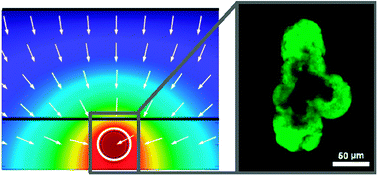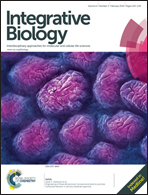Engineering of three-dimensional microenvironments to promote contractile behavior in primary intestinal organoids†
Abstract
Multiple culture techniques now exist for the long-term maintenance of neonatal primary murine intestinal organoids in vitro; however, the achievement of contractile behavior within cultured organoids has thus far been infrequent and unpredictable. Here we combine finite element simulation of oxygen transport and quantitative comparative analysis of cellular microenvironments to elucidate the critical variables that promote reproducible intestinal organoid contraction. Experimentally, oxygen distribution was manipulated by adjusting the ambient oxygen concentration along with the use of semi-permeable membranes to enhance transport. The culture microenvironment was further tailored through variation of collagen type-I matrix density, addition of exogenous R-spondin1, and specification of culture geometry. “Air–liquid interface” cultures resulted in significantly higher numbers of contractile cultures relative to traditional submerged cultures. These interface cultures were confirmed to have enhanced and more symmetric oxygen transport relative to traditional submerged cultures. While oxygen availability was found to impact in vitro contraction rate and the orientation of contractile movement, it was not a key factor in enabling contractility. For all conditions tested, reproducible contractile behavior only occurred within a consistent and narrow range of collagen type-I matrix densities with porosities of approximately 20% and storage moduli near 30 Pa. This suggests that matrix density acts as a “permissive switch” that enables contractions to occur. Similarly, contractions were only observed in cultures with diameters less than 15.5 mm that had relatively large interfacial surface area between the compliant matrix and the rigid culture dish. Taken together, these data suggest that spatial geometry and mechanics of the microenvironment, which includes both the encapsulating matrix as well as the surrounding culture device, may be key determinants of intestinal organoid functionality. As peristaltic contractility is a crucial requirement for normal digestive tract function, this achievement of reproducible organoid contraction marks a pivotal advancement towards engineering physiologically functional replacement tissue constructs.


 Please wait while we load your content...
Please wait while we load your content...